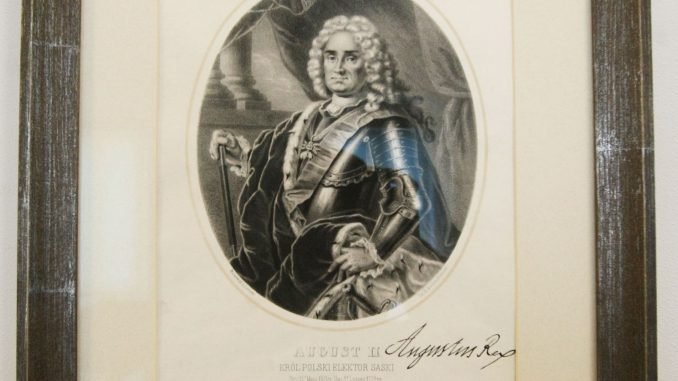
The Vision of Augustus II: Saxony’s Wealth and the Commonwealth’s Expanses
At the turn of the 18th century, the rule of law of the Commonwealth was different than that of its neighboring states. We can distinguish three different groups of states that dominated at the time in Europe. The first were states where there was a strong hereditary monarchy (France, Russia, Denmark, and a number of German grand duchies). The second were states, the lever of power of which lied in the hands of organs represented by society (the Commonwealth, in part Switzerland, Venice, the Grand Duchy of Mecklenburg-Schwerin, and England). The third were states had a system that had traits of both the first and second groups (the Netherlands and Sweden until 1680). An undeniable trait of the rule of law in the Commonwealth that made it stand out from neighboring states was the free elections of the monarch and the right of every boyar to take part in them. At the same time it was the main barrier in strengthening the monarch as an institution.
Augustus II had more power in Saxony than in the Commonwealth. In the Commonwealth, he was not an absolute ruler, and he had to regularly fight with the local gathering of the nobility (especially on the topic of taxes) and with the Sejm. One can observe the constant goal of his to strengthen his power in both states over the entire period of his rule. He planned on doing this by changing the personal union between Saxony and the Commonwealth into a strong and unbreakable tie with a real union. In 1569, with the creation of the Union of Lublin, Lithuania as the weaker partner, had yielded to Poland. The economic advantage of Saxony at the beginning of the 18th century should have led to the Commonwealth taking on the role of the younger brother. Given the size of the Commonwealth’s territory, number of inhabitants and national resources, great opportunities were to be had if this political program was carried out.
One Foot in Absolutism
One can observe a number of Augustus II’s steps in strengthening the ties between Saxony and the Commonwealth. The diplomatic representation of the Commonwealth in foreign countries was replaced by the Saxon diplomatic corps from the very first years of his rule. Later on the most important issues of Saxony and the Commonwealth were decided in the circle of Augustus II’s most trusted advisors in his secret cabinet, the absolute majority of which were Saxon ministers. It was the decisions adopted there that the ruler strove to adopt in the Senate Council. In 1710, Augustus II was able to force the Sejm of the Commonwealth to accept 8,000 Saxon soldiers and officers into the Polish and Lithuanian military forces, and paying them from the treasury of the Commonwealth. After the Silent Sejm of 1717, for a few years they were able to take the best part of the Polish and Lithuanian armies from the command of the hetmans and give them over to the rule of his favorite Saxon Jakob von Flemming. The tax sector was also not able to avoid the intervention of Augustus II.
In 1713-15 the Commissariat of the Royal Saxon Army established in Warsaw announced taxes for supporting the Saxon army without the approval of the Sejm or local sejms. Augustus II wasn’t even able to do this in Saxony. The explanation as to why these successes were short-lived and why all of Augustus II’ plans collapsed is rather simple – Saxony was much too weak of a support for reforms in the Commonwealth. At the beginning, Augustus II’s plans were hindered by losses to Sweden, then the Tarnogród and Vilnius Confederations that arose in the Commonwealth, and later strong neighbors Russia and Prussia, which made an agreement to preserve the old system of the Commonwealth. The planned reforms of Augustus II failed, the authority of the Commonwealth leader lessened, and decentralization was a threat. The monarchy experienced its greatest crisis as an institution of power when Augustus III, the son of Augustus II, ruled the state from 1733 to 1763.
Boyar Democracy: A System Ahead of its Time or Despotism and Chaos?
The Commonwealth was never so close to absolutism as it was under the rule of Augustus II. The standing taxes, limits of power of the hetmans and local sejms that were introduced in the Sejm in 1717 were the first important reforms, which were noted by an envoy of Prussia to the Commonwealth: “It’s a fantastic foundation for absolute power.” But we do not need to lament, that they were not able to introduce absolutism in the Commonwealth. Absolutism as a system of government was not the cure for all ills of other states. The strong reign of a ruler was not able to save Spain from its downfall; Denmark and France experienced stagnation in the 18th century. Absolutism and the arbitrary policies of Charles XII were important factors for Sweden that resulted in a catastrophic decline at the beginning of the 18th century.
From the view of a modern democracy, the reforms at the end of the 18th century allowed the Commonwealth to be among the leading nations in Europe. Though most European nations lived through one or another form of absolutism on the road to democracy, the Commonwealth was able to skip this phase (which also in part happened in England). This shows that the Commonwealth’s rule of law was equal to that of other states. At the beginning of the 18th century, it had just as good prospects to develop its geopolitical aspirations as other states.
